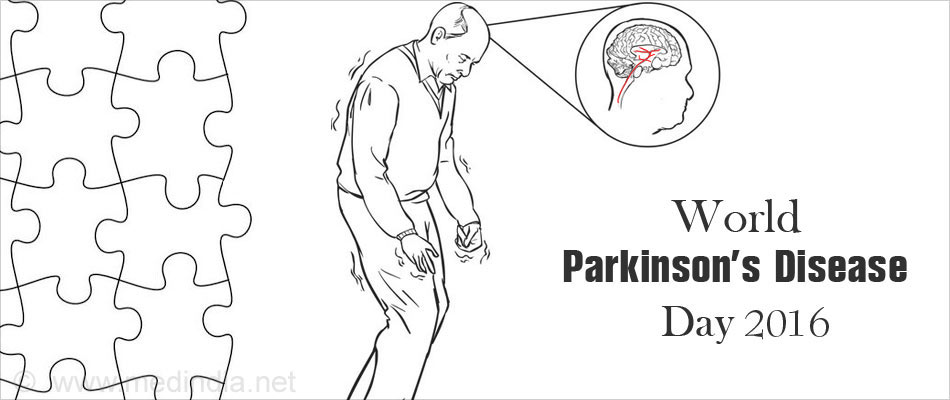
- World Parkinson’s Day is on 11th April 2016
- Parkinson’s Disease is the second most common neurodegenerative disorder next to Alzheimer’s disease
- The day focuses on raising funds for Parkinson’s research and accelerating steps to find a cure
Global Burden
- Seven million people currently live with Parkinson’s disease in the world
- One million Americans suffer from the disease while 60,000 Americans are diagnosed with it every year
- Parkinson’s disease affects people above 50-60 years of age predominantly
- Men are one and a half times more likely to get affected by the disease than women
Parkinson’s disease is a debilitating disease that results in the death of the vital neurons in the brain. Neurons play a significant role in sending signals across all organs in the body. Neuronal damage in Parkinson’s disease predominantly occurs in the brain region called as the substantia nigra. These neurons are responsible for secreting a hormone called as dopamine, which plays a key role in control and co-ordination of muscle movements. The death of these neurons leads to decrease in dopamine, resulting in movement disorders.
Causes and Symptoms of Parkinson’s Disease
Parkinson’s disease is of two types namely,
Secondary Parkinson’s disease or Inherited: Though Parkinson’s disease is not termed to be hereditary, some genes may play a role in the development of PD when combined with environmental toxins or viruses.
- Tremor: It involves involuntary shaking of the hand, usually starts on one side and can spread to other parts of the body.
- Rigidity: Stiffening of muscles leading to inflexibility, pain and muscle cramps.
- Slowness of Movement (Bradykinesia): Difficulties in performing tasks and taking a longer time to do things.
- Postural Instability: Impaired balance and frequent falls leading to increased bone fractures.
- Psychiatric problems: Anxiety, depression, hallucinations, memory problems and even dementia
- Sleep problems: Sleeping difficulties, insomnia, difficulty to turn on the bed, restless leg syndrome, frequent urination during night time and sleep apnea
- Vision abnormalities: It can lead to blurred vision, double vision or dry eyes.
In Parkinson's disease, the neurons in the substantia nigra get damaged leading to a reduction in dopamine while in Parkinsonism, both the death of cells in the substantia nigra, as well as degeneration of the dopamine receptors (striatum region of the brain), occurs. This makes parkinsonism treatment much more challenging than PD as it does not respond to typical Parkinson’s disease medications and treatment.
Living with Parkinson’s Disease
Till now, there is no cure for Parkinson’s disease, but some of the treatments for Parkinson’s disease include medications that increase dopamine secretion such as levodopa, dopamine agonists and MAO-B inhibitors. Other interventions recommended are surgical (deep brain stimulation), rehabilitation, regular exercise and physiotherapy.
Living every day with Parkinson's disease is a challenge as it is full of issues and obstacles. PD decreases the quality of life of patients as well as their caregivers . Patients may often isolate themselves from others, feel embarrassed about themselves and find it difficult to lead an independent life. In the early stages, they may even hide their symptoms, making it even more difficult for diagnosing the condition.
Stress is considered to be one of the worst barriers for coping with PD. It heightens the symptoms and also triggers anxiety, depression and other mental health problems. But effective management of the disease by following these steps can help reduce stress and mental drain among the patients and caregivers.
- Visit your doctor regularly and follow recommended interventions
- Engage yourself in reading, painting and other leisure activities to reduce stress
- Join a local group that offers physical therapy, exercise interventions to improve flexibility
- Maintain healthy relationships with family and friends
- Eat a healthy diet and follow routine sleep timings
- If you are a caregiver, taking time for yourself can benefit you and the patient
Though Parkinson’s disease affects an individual, its effects are also faced by their family and friends. Therefore, it is our primary duty to accept people with this disorder and offer timely support and care. Eliminate stigma associated with these patients and stop looking at them differently.
So, on this World Parkinson’s Day, let us strive to,
- Educate societies about Parkinson’s disease
- Improve care and treatment for those affected by PD
- Increase investment in Parkinson’s disease-related research and development
- Focus on the need of the contribution by all to improve Parkinson’s disease awareness and care
- https://en.wikipedia.org/wiki/Parkinson%27s_disease
- http://www.pdf.org/en/chasing_parkinsons_cure
- http://www.parkinson.org/understanding-parkinsons/treatment
Source-Medindia









